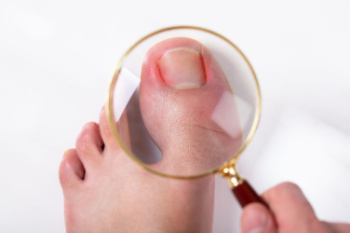Who Is at Risk for Ingrown Toenails?
Tuesday, 18 June 2024 00:00 Ingrown toenails occur when the edge of a toenail grows into the surrounding skin, causing pain, swelling, and sometimes infection. Those at higher risk include individuals with curved or thick nails, those who trim their nails improperly, people who wear tight or ill-fitting shoes, and athletes or dancers who frequently stress their feet. Symptoms of ingrown toenails include redness, swelling, pain along the nail edges, and, in severe cases, pus or infection. Common causes are improper nail trimming, trauma to the toenail, and genetic predisposition. To prevent ingrown toenails, trim nails straight across, avoid cutting them too short, and wear shoes that provide adequate space for the toes. Relief for mild cases includes soaking the foot in warm water and keeping the foot clean. If you have severe symptoms of an ingrown toenail or it appears infected, it is strongly suggested that you schedule an appointment with a podiatrist who may prescribe antibiotics or possibly a minor surgical procedure.
Ingrown toenails occur when the edge of a toenail grows into the surrounding skin, causing pain, swelling, and sometimes infection. Those at higher risk include individuals with curved or thick nails, those who trim their nails improperly, people who wear tight or ill-fitting shoes, and athletes or dancers who frequently stress their feet. Symptoms of ingrown toenails include redness, swelling, pain along the nail edges, and, in severe cases, pus or infection. Common causes are improper nail trimming, trauma to the toenail, and genetic predisposition. To prevent ingrown toenails, trim nails straight across, avoid cutting them too short, and wear shoes that provide adequate space for the toes. Relief for mild cases includes soaking the foot in warm water and keeping the foot clean. If you have severe symptoms of an ingrown toenail or it appears infected, it is strongly suggested that you schedule an appointment with a podiatrist who may prescribe antibiotics or possibly a minor surgical procedure.
Ingrown toenails may initially present themselves as a minor discomfort, but they may progress into an infection in the skin without proper treatment. For more information about ingrown toenails, contact John Horlebein, DPM of Northern Cascades Foot & Ankle, LLC. Our doctor can provide the care you need to keep you pain-free and on your feet.
Ingrown Toenails
Ingrown toenails are caused when the corner or side of a toenail grows into the soft flesh surrounding it. They often result in redness, swelling, pain, and in some cases, infection. This condition typically affects the big toe and may recur if it is not treated properly.
Causes
- Improper toenail trimming
- Genetics
- Improper shoe fitting
- Injury from pedicures or nail picking
- Abnormal gait
- Poor hygiene
You are more likely to develop an ingrown toenail if you are obese, have diabetes, arthritis, or have any fungal infection in your nails. Additionally, people who have foot or toe deformities are at a higher risk of developing an ingrown toenail.
Symptoms
Some symptoms of ingrown toenails are redness, swelling, and pain. In rare cases, there may be a yellowish drainage coming from the nail.
Treatment
Ignoring an ingrown toenail can have serious complications. Infections of the nail border can progress to a deeper soft-tissue infection, which can then turn into a bone infection. You should always speak with your podiatrist if you suspect you have an ingrown toenail, especially if you have diabetes or poor circulation.
If you have any questions, please feel free to contact our office located in Chelan, WA . We offer the newest diagnostic and treatment technologies for all your foot care needs.






